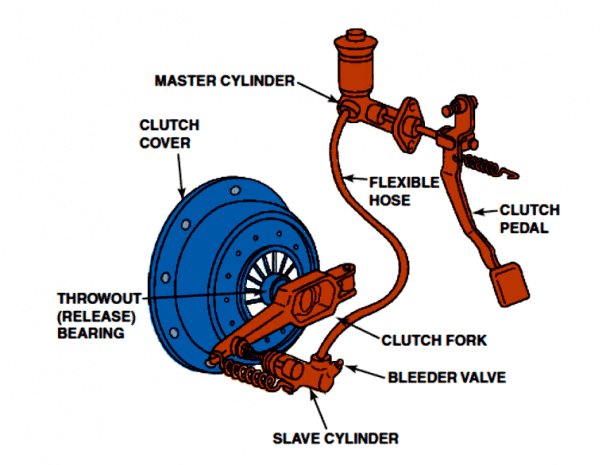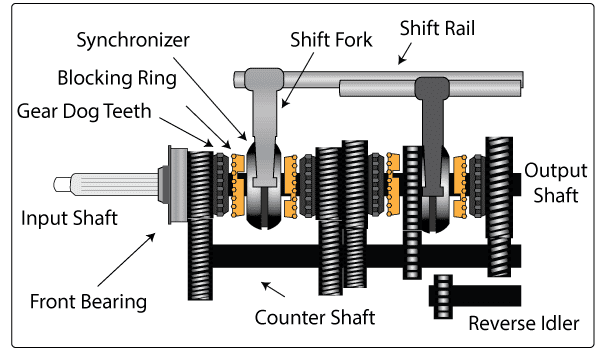Today at Wonderful Engineering you will learn how does the majestic and magnificent manual transmission operate. What are the components and the mechanisms that keep the wheels churning and what ingenious mechanisms are employed behind the stick drive.
The components of a manual transmission
Before understanding how does the gearing system operate, it is imperative to know what are the components which make this possible:
- Clutch Pedal: This is the dreaded third pedal, which all you auto transmission fans have nightmares about. It is a mechanical contact and disengages the clutch when you depress it. Typically this is controlled hydraulically, although sometimes forks and cables are also used.
- Clutch: Clutching system is a set of components used to transmit engine torque to the transmission and eventually the drive. Its key components include a pressure plate, a diaphragm spring, a clutch disc, a throwout bearing, and other components like bolts, washers etc. The actual clutch disc is a kind of friction device sandwiched between the flywheel and the pressure plate.

Hydraulic Clutching System and Components [Pic Credits howstuffworks] 
- Flywheel: The flywheel has many functions, but in our case it is the component which transmits engine torque to the clutch disc. The clutch disc interacts and latches onto the smooth surface of the flywheel in order to move with the same angular momentum.Below is a video on how the flywheel mechanism operates:
- Selector Fork: This selector fork arm is used to move the collars along the output shaft and can be moved using the gear shift in order to select the gears.
- Collar: The collar is where the show down occurs, and is used to select the different gears. It slides between the gears, and meshes with them. It is usually splined to the output shaft, and the gears rotate with the layshaft. The collars is locked with a selected gear, and the engine torque passes from the layshaft to the output shaft.
- Synchronisers: These are located between the gears and the collars, allowing the collars to engage with the gear even if there is difference in the speed of the two. Essentially, it helps in annulling the speed of the gear and the collar.
- Layshaft: Engine power is directed towards the layshaft, which contains gears which mesh to the gears on the output shaft. This is also referred to as a countershaft.
- Output shaft: All the gears are mounted on the output shaft resting on bearings, and thus they don’t rotate with the layshaft. The output shaft and layshaft rotates together only when when a gear is meshed with the respective collar, and at that time the output shaft will rotate at the rate at which the engaged gear is spinning.
- Gears: Gear size and ratios determines the torque and speed outputs. Larger gears will allow more torque but have low speeds, while smaller gears having with fewer teeth will provide less torque, but will move at a higher speed.
The Mechanism:
The process of changing gears is as follows:
With the car at a stop, the clutch pedal is pressed, and this causes the throwout bearing to press against the diaphragm spring; releasing the hold of the clutch disc between the pressure plate and the flywheel. By pressing the clutch, the engine and transmission are no longer linked.
As soon as the clutch is released, the clutch plate pressed by the pressure plate gets into the mechanical contact with the flywheel. Thus now the engine and the transmission are directly connected and moving with each other.
The first gear is selected by moving the gear lever into the first gear mark, which causes the selector fork to mesh the collar between gears one and two into the first gear.
Now in order to make the car move, apply the throttle lightly and release the clutch pedal gently with the left foot. Gradually increase the throttle while releasing the clutch. Once the clutch is fully released, your car is in first gear and the engine and transmission are fully linked.
The same process is repeated to shift between the gears. The gear selector is moved to the corresponding gear positions, which pulls the collar out of current gear and engages it with the desired next gear.
When the car has to be stopped, the driver again presses the clutch in order to place the gear shift in the centre/neutral. In this position, no gears are engaged then the clutch can be released safely. It is a good habit to leave the car in neutral whenever you stop or turn off the car, as not doing this can lead to wearing of the throwout bearing.
Here is a wonderful video on how a manual transmission work:
Did you enjoy our article? Have more to add to this information?
Comment below!





